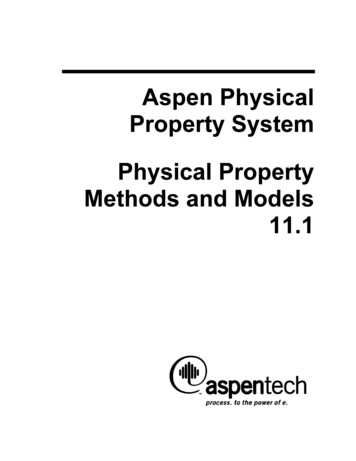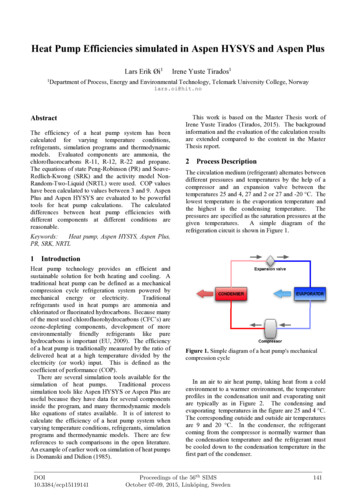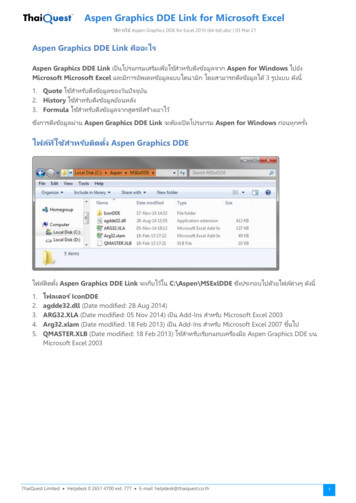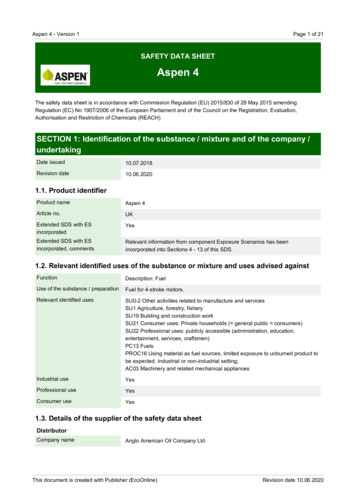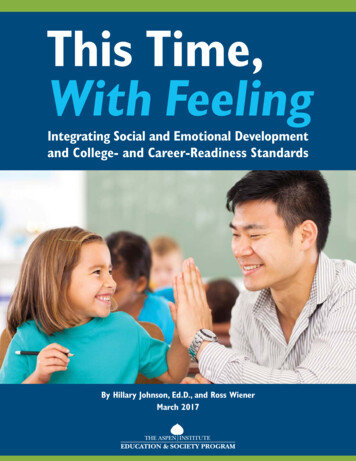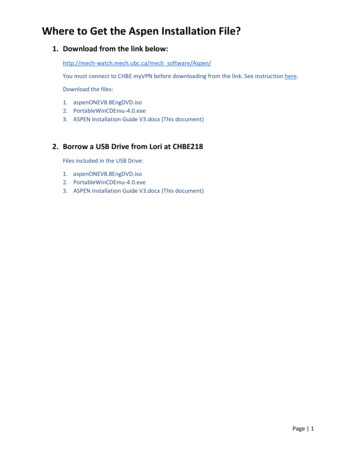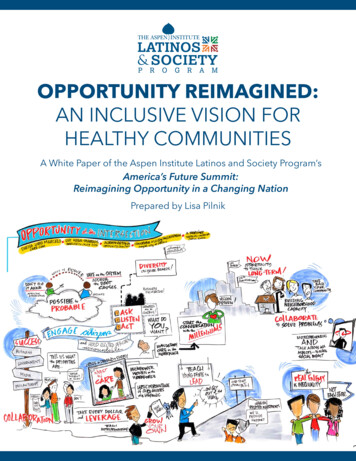
Transcription
OPPORTUNITY REIMAGINED:AN INCLUSIVE VISION FORHEALTHY COMMUNITIESA White Paper of the Aspen Institute Latinos and Society Program’sAmerica’s Future Summit:Reimagining Opportunity in a Changing NationPrepared by Lisa Pilnik
This white paper Opportunity Reimagined: An Inclusive Vision for HealthyCommunities is the result of discussions held during the America’s FutureSummit: Reimagining Opportunity in a Changing Nation. None of thecomments or ideas contained in this paper should be taken as embodyingthe views or carrying the endorsement of any specific participant at thegathering or of any of the supporting donors.Opportunity Reimagined: An Inclusive Vision for Healthy Communitiesis licensed under Creative Commons Attribution-Non-CommercialShareAlike 4.0 International License.Copyright 2016 by The Aspen InstituteThe Aspen InstituteOne Dupont Circle, NW Suite 700 Washington, DC 20036Published in the United States of America in 2016 by The Aspen InstituteAll rights reservedFront & back cover illustrations by Sophia Liang, Founder and Principal, Graphic Foot Pprints
TABLE OF CONTENTSAcknowledgements. 2Executive Summary. 3Introduction. 5What is a healthy community?. 5A Lens on Latinos in America. 5America’s Future Summit. 7Health Equity. 9Education as a Pathway to Opportunity and Healthy Communities. 11Creating and Sustaining Economic Opportunity. 15Building and Sustaining an Equity Agenda. 18Conclusion. 22
ACKNOWLEDGEMENTSThe Latinos and Society Program wishes to thank The California Endowment, specifically the efforts of BeatrizSolis, Program Director, Healthy Communities South Region and Rocio Bonsall, Program Associate for supportingthe creation and dissemination of this white paper. As the content of this white paper is derived principallyfrom conversations and presentations that took place at the 2nd Annual America’s Future Summit: ReimaginingOpportunity in a Changing Nation, we would like to acknowledge the speakers and participants in attendance andalso the generous support of the sponsors who made the Summit possible: Target as title sponsor, with additionalsupport from The California Endowment, Comcast/NBCUniversal Telemundo, The Ricardo Salinas Foundation,Toyota Motor North America, Inc., Edison International, and the Weingart Foundation.We would also like to thank the author, Lisa Pilnik, who wove together content from various sources and formatsgenerated during the Summit to articulate the key issues and recommendations for building healthy communitiesand advancing opportunity for Latinos and all Americans; and Sarah Alvarez, Program Associate for the Latinos andSociety Program, for leading the production and dissemination of this white paper. Additionally, we would like toacknowledge Sophia Liang, Founder and Principal, Graphic Footprints who created visual representations of keymessages and themes from the Summit that can be seen on the front and back cover of this white paper.2THE ASPEN INSTITUTE
EXECUTIVE SUMMARYIn August 2016, The Aspen Institute Latinos and Society Program convened the America’s Future Summit: Reimagining Opportunity in a Changing Nation, in Los Angeles, California, bringing together 200 diverse thought leadersto discuss pathways to opportunity and strategies for achieving equity for all Americans, particularly the American Latino community. The Summit’s organizers and participants recognized that in order for a community to behealthy, all of its members must have equitable access to opportunity. This paper is derived from content generated during and after the Summit and seeks to highlight some of the most important components for expandingopportunity:Health equity, meaning all community members have access to physical and mental health careservices, and that all communities—including those traditionally left behind—have equal access to safepedestrian routes, places to play and exercise, and that low income and communities of color are notdisproportionately burdened with environmental hazards such as lead or air pollution.Education access, referring to the broad availability of high caliber and affordable pre-K throughpost-secondary at a minimum; as well as improved schools and how they prepare young people,knowledge-building through mentorship, public civic education, and other education strategies thatadvance equity.Economic opportunity, or access to the means to support yourself, build personal wealth, and contribute to your community, whether through a well-paid job or through entrepreneurship.An Equity agenda, meaning that all aspects of policy and practice, across sectors, include a focus onensuring equity and that it is built into all of the work that they do; this is essential for achieving accessto and realizing the full potential of opportunity.Much hard work has already been done on these fronts across America and for Latinos in particular, but moreremains to be done. Strategies discussed during the America’s Future Summit, that have contributed to previouslysuccessful efforts to improve equity, opportunity and healthy communities and that should be accounted for infuture efforts, include:Collaboration across a broad range of sectors (e.g., schools, government, business, community organizations, and philanthropy) as well as among impacted populations (e.g., low income and communitiesof color).Addressing root causes that impact an individual, family, or community’s ability to take advantage ofopportunity, such as trauma, violence, and poverty (e.g., providing mental health services in conjunction with job training).Community member and youth involvement in all efforts that impact the community, including educating individuals on how and why to advocate, as necessary. An important principle in an equity agendais that those most affected must be the ones driving the work and developing the solutions. In manyOPPORTUNITY REIMAGINED: AN INCLUSIVE VISION FOR HEALTHY COMMUNITIES3
communities, and particularly considering the age demographics among Latinos in the U.S., this meansthat we need to provide young people with opportunity, and then get out of the way so that they canbe the ones creating and driving efforts.Latino leadership in education, business, politics, philanthropy, and other fields that are central to facilitating opportunity, including the presence of relatable role models young Latinos can look to.Relevancy to target populations, for Latinos, this means not just making information available inSpanish (for those whose dominant language is not English), but also working with Latino leaders andcommunity members to ensure that efforts and methods are culturally appropriate and that communitymembers who are undocumented are equally able to access services and supports.Place based efforts, grounded in and responsive to the particular geographic and environmental qualities of the communities they are working to impact.4THE ASPEN INSTITUTE
INTRODUCTIONWhat is a healthy community?Americans increasingly recognize that life expectancy, disease rates, and other indicators of behavioraland physical health are impacted by both medical elements (such as access to health care) and social andenvironmental factors (such as availability of quality schools and clean air). We are also increasingly aware thatin order for a community to be healthy, all of its members must be healthy and that communities must have fullparticipation from—and access to opportunity for—all members. These conversations about health equity and equalaccess to opportunity have broad intersections: health is impacted and determined by an individual’s access toeducation and jobs and also the policies and practices that support or limit the individual, such as policing, racism,and disinvestment in their communities. At the same time, the very existence of employment and educationalopportunities, as well as high levels of incarceration and trauma, have major effects on physical and behavioralhealth. Healthy communities are those who have positive physical and behavioral health outcomes, but also dowell on social, economic, and civic measures.A Lens on Latinos in AmericaThere are many reasons to focus on Latinos when considering how to create and improve access to opportunityand healthy communities. First, the size of the population: there are 56.6 million Latinos living in the United States,1and Latinos made up 54% of U.S. population growth from 2000 to 2014.2 Secondly, the Hispanic population is alsosignificantly younger than other groups, with a median age of 28 (compared to 43 for whites and 33 for AfricanAmericans).3 U.S. born Latinos are the youngest of any major ethnic/racial group--47% are under age 18.4 Despitethese demographic imperatives, Latinos experience many disparities in health and life outcomes: Latinos are more likely than any other major ethnic/racial group to lack health insurance coverage and aremore likely than the white population to suffer from low birth weight and obesity.51 U.S. Census Bureau. "Sumter County, Fla., is Nation’s Oldest, Census Bureau Reports," June 23, 2016, available at /cb16-107.html2 Jens Manuel Krogstad. "Key facts about how the U.S. Hispanic population is changing." Pew Research Center/FactTank. September 8, 2016.Available at hanging/ Note that thisreport stated that Latino population growth is declining, although still growing at a rate of 2.8% each year (down from 4.4% each year prior from2000-2007).3 Eileen Patten. “The Nation’s Latino Population Is Defined by Its Youth.” Pew Research Center. April 20, 2016 Available at latino-population-is-defined-by-its-youth/4 Eileen Patten. “The Nation’s Latino Population Is Defined by Its Youth.” Pew Research Center. April 20, 2016 Available at latino-population-is-defined-by-its-youth/5 U.S. Department of Health and Human Services Office of Minority Health. "Profile: Hispanic/Latino Americans" available at http://minorityhealth.hhs.gov/omh/browse.aspx?lvl 3&lvlid 64.OPPORTUNITY REIMAGINED: AN INCLUSIVE VISION FOR HEALTHY COMMUNITIES5
Over 25% of Latinos live in poverty (compared to 11% of whites) and the average median household incomefor full-time/year-round Latino workers in 2014 was 40,417 (compared to 56,565 for whites). Latinos aremore likely to work in service occupations and less likely to work in managerial/professional settings thannon-Hispanic whites as well.6 Although the high school dropout rate for Latino students has dropped significantly, 12% of Latinos stillleave high school without a degree (compared to 7% of blacks, 5% or whites and 1% of Asians). Only 15% ofLatinos age 25 to 29 hold at least a bachelor's degree (compared to 41% of whites, 22% of blacks, and 63%of Asians in the same age group).7 Hispanics are jailed at 1.4 times the rate of whites nationally, with that rate being significantly higher (3times the rate or more) in several states. Note that this is likely an undercount because some states don'tcomprehensively collect/report data about ethnicity.8All groups within a community must be included in order for society as a whole to thrive and be healthy; given thelarge and growing number of Latinos in the U.S. coupled with the current inequities they face, the distinct needs,strengths, and circumstances of Latinos should receive special attention when we consider how to address healthequity and access to opportunity in America.6 U.S. Department of Health and Human Services Office of Minority Health. "Profile: Hispanic/Latino Americans" available at http://minorityhealth.hhs.gov/omh/browse.aspx?lvl 3&lvlid 64.7 Jens Manuel Krogstad "5 facts about Latinos and education." Pew Research Center/FactTank. July 28, 2016. Available at facts-about-latinos-and-education/8 Ashley Nellis, Ph.D. "The Color of Justice: Racial and Ethnic Disparity in State Prisons." June 2016. Available at isparity-in-State-Prisons.pdf6THE ASPEN INSTITUTE
AMERICA’S FUTURE SUMMITRecognizing that equitable access to opportunity and creating healthy communities are inextricably linked, theAspen Institute Latinos and Society Program focused on pathways to opportunity and strategies for achievingequity during its 2016 America’s Future Summit: ReimaginingOpportunity in a Changing Nation (the “Summit”). TheSummit took place in Los Angeles, California, a multicultural“While we live in a land of opportunity, we knowcity of the future, offering examples of cross-cultural andthat opportunity is not equally accessible to all.cross-sector collaboration and coalition building that mayserve as models for the Latino community and the nation.Your zip code, the color of skin, your gender,This paper draws from insights and knowledge shared byyour immigration status, your language deterpresenters and participants at the Summit, as well as from keymine whether you have access to the tools andbackground resources relied on by the Summit’s organizers.9This paper looks at key issue areas that are essential forhealthy communities: health equity, economic opportunity,and education. It also recognizes that an equity agenda (e.g.,the systematic inclusion of equity in every aspect of policy,programming, and practice)10 must be part of any healthycommunity and included in each of the areas listed above.Although distinct challenges and strategies were discussedin each of those areas, many common themes emergedincluding the importance of: collaborating, centering effortson communities that have been traditionally left behind;addressing root causes of inequity; partnering with affectedcommunity members and ensuring that they are drivers ofchange; and increasing the participation of Latinos and otherpeople of color in a wide array of sectors and as leaders inpositions of power.onramps to opportunity. We are all accountablefor ensuring that equity, fairness, and upwardmobility apply to all communities. So today, letus ask ourselves: how can we ensure that everyone is invited and welcomed and has full accessto a level playing field, is able to fully reach theirpotential and contribute at the highest levels.”Monica LozanoChair, Aspen Institute Latinos and Society Program(Click here for video of remarks)9 When not otherwise attributed, the ideas and assertions presented throughout are based on speakers' presentations and notes from smallgroup discussions that took place during the Summit.10 The definition of equity agenda used here (and throughout this paper) was developed by the Aspen Institute Latinos and Society Program,and draws from the work of Angela Glover Blackwell, CEO of PolicyLink. See, e.g., “America’s Tomorrow: Race, Place, and the Equity Agenda,”available at 0rLIU.OPPORTUNITY REIMAGINED: AN INCLUSIVE VISION FOR HEALTHY COMMUNITIES7
LEARNING FROM LATINOS ABOUT THEIR PRIORITIESIn partnership with the America's Future Summit: Reimagining Opportunity in a Changing Nation, Nielsen’s Harris Poll asked respondents across the country what they thought was necessary to increaseopportunity for themselves and people like them.Hispanic respondents listed the following as their top priorities:11 "Affordable, quality health care" (77%) "Elected officials who are held accountable for their decisions" (76%) "Safe neighborhoods" (73%) "Good jobs that offer a living wage" (73%)Among Spanish language dominant Hispanics, "convenient and reliable public transportation" rankedextremely important or absolutely essential by 70% of respondents, compared to Bilingual or EnglishDominant Hispanics at 49% and 39% respectively, indicating differences in priorities within the Latinocommunity by language preference. Asking community members themselves what they need canprovide valuable insights and help target programs and services where they can have the greatest impact.11 Respondents were asked to rate the importance of 15 different factors as either Absolutely Essential, Extremely Important, Very Important,Somewhat Important, Not At All Important.8THE ASPEN INSTITUTE
HEALTH EQUITYMany factors contribute to health, well-being, and success in life, but perhaps no single determinant is moreimportant than where you live. A person’s zip code can predict their physical and behavioral health outcomes,likelihood of attending college or being unemployed, and overall life expectancy. Although health equity caninclude all of the social determinants of health, this section primarily focuses on physical and behavioral health.Individuals who are not in good health are not as able to grasp or fully realize the benefits of opportunity. Forexample, someone experiencing chronic pain may not be able to focus on and perform as well at school or work.The non-health benefits of opportunity, such as good jobs, may also mean less if individuals who have access tothem also have lower life expectancies or high rates of life-threatening diseases.Many physical, environmental, and geographic factors can contribute to poor physical health, such as: The phenomenon of food deserts where community members do not have access to affordable, fresh, andhealthy food because there are no stores selling them in their neighborhood. Lower rates of exercise because there are not safe spaces for children or adults to run or play or safe routesfor them to walk to school or work. Presence of lead in homes or schools, safe drinking water, or air pollution.Communities with fewer resources may also lack access to health care, including access to preventative measuressuch as immunization. Violence and deprivation experienced by community members may lead to higher rates oftrauma, poor educational performance, and substance abuse. Lack of opportunities and resources in underservedcommunities can also affect health and well-being in broader ways, such as underperforming schools or lackof living wage jobs—the barriers and potential strategies related to education and economic opportunity arediscussed in greater detail later in this paper.Achieving ChangeResolving physical and behavioral health issues will require investments of resources in underserved communities,as well as policy change. An example of such policy change includes providing incentives for grocery stores toopen businesses in underserved areas (paired with public education about healthy eating) or provision of mentalhealth services. It also means ensuring that programs reach all community members, including those who do notspeak English and/or are undocumented. Locating these services in places community members are familiar withand already regularly access can contribute to their utility (e.g., a health and wellness center in a predominatelyLatino neighborhood’s high school, as discussed in a later section on students and civic engagement).For Latino leaders working to eliminate barriers to opportunity, grassroots advocacy may require something of aculture shift. As mark! Lopez, Executive Director, East Yard Communities for Environmental Justice explains, “[in]the communities that we come from, we weren't traditionally disrupters. [It] wasn't till coming here that we hadOPPORTUNITY REIMAGINED: AN INCLUSIVE VISION FOR HEALTHY COMMUNITIES9
to be[come] disrupters, that we had to disrupt systems of oppression to create community here, whether it wasEnglish only at schools or environmental racism.”12 Like many other primarily minority communities, SoutheastLos Angeles has disproportionately unhealthy air quality and lacks adequate sidewalks, stop signs, and other toolsthat ensure pedestrian safety. Lopez’ group uses a variety ofstrategies to protect the health of residents and, therefore,increase their chances of accessing opportunity and fully“There's a lot of work ahead, we're up againstrealizing its potential. For example, it campaigns to keep outa lot, but what gets me out of bed every day.contributors to pollution such as rail yards and truck trafficis that there are lives at stake and the more weby educating community members so they can advocate forleave these young people by the wayside, we'retheir own health, actively engaging with local government,and aggressively litigating when necessary. Lopez alsolosing lives. In my community.young peopleexplains that one of the biggest challenges his group facesare dying due to the lack of opportunity [andis “getting people to understand that the situations we findthat's why] we need to keep pushing."ourselves in now aren't normal,” citing as examples policeshootings and the fact that there are 2,000 premature deathsLashon Amadodue to air quality in his community each year.National Coordinator of Community Action Teams,Opportunity Youth United(Click here for video of remarks)Although opportunity is often associated with educationand ultimately employment, there is a growing body of workrecognizing that individuals who are grieving, traumatized,or dealing with other mental health or substance abuseissues may not be able to benefit from educational or vocational programs unless those issues are addressed.Community-based programs can be essential for connecting young people to opportunity, while also addressingunmet health needs. The Summit highlighted one such program, Homeboy Industries, which puts many of thestrategies discussed in this paper into action. Homeboy provides a wide range of services for formerly ganginvolved or incarcerated individuals, including case management, mental health and substance abuse services,parenting and anger management classes, and education and vocational training. Father Boyle, the importance ofthe program’s founder, and two participants spoke about their experiences with the program. Both emphasized theimportance of therapy provided, as well as other services that allow trainees to work on themselves. They cited theprovision of these services as a key factor in allowing men and women to heal and, therefore, to take full advantageof all of the other opportunities Homeboy offered them.12 Unless otherwise noted, all quoted statements are from presentations at the Summit.10THE ASPEN INSTITUTE
EDUCATION AS A PATHWAY TOOPPORTUNITY AND HEALTHY COMMUNITIESEducation is widely considered one of the most important pathways to opportunity, and educational attainmentis frequently considered in measures of community health. Yet the quality of education varies widely acrosscommunities, and Latinos in particular have higher high school dropout rates and lower levels of 4-year collegecompletion. Safe, supportive schools that nurture students can further opportunity and health for Latinos, andall community members13. Yet, participants at the Summit identified many barriers that prevent educationalattainment, including the fact that too many schools, at best, fail to engage students and, at worst, criminalize themand cut them off from society/community and a healthy future.Achieving ChangeParticipants at the Summit identified a number of potential strategies for increasing educational success amongLatino and other young people in several different areas:Improving school climate and providing role models: Improving school-wide culture and relationships between students and teachers/staff and fighting thecriminalization of students.14 Undertaking targeted efforts to increase the number of Latino teachers, administrators, and educationalleaders. This is essential because all youth, but especially Latinos and youth of color, need to see people wholook like them or that they can relate to as role models. Participants noted that increasing these numbersmay require large scale changes, such as better pay and treatment of teachers and other educationalprofessionals. Increasing availability of mentoring and other opportunities and efforts that meet young people wherethey are. Los Angeles Mayor Eric Garcetti shared that Los Angeles holds a dropout prevention day wheregovernment officials, school administrators, business leaders, and others knock on the apartment doors ofyoung people who have dropped out to personally encourage them to re-engage in school.13 The National Center for Safe and Supportive Learning Environments suggests that in order to create environments that support learning,attention to the physical health and safety needs of the entire school community must be taken into consideration. Further information aboutsafe, supportive schools is available at ch/environment/physical-health14 Although the issue of school discipline disparities and school climate were not discussed in depth at the Summit, participants in the lunch table discussions articulated concerns about the criminalization and dehumanization of students as a barrier to accessing and utilizing educationas an opportunity. Helpful resources on this topic include “Ending the Schoolhouse to Jailhouse Track” by the Advancement Project the-school-to-prison-pipeline and “Rethinking Discipline” by U.S. Department of Education ne/index.html.OPPORTUNITY REIMAGINED: AN INCLUSIVE VISION FOR HEALTHY COMMUNITIES11
Tackling community and system-level factors: Awareness-raising efforts around how the country is impacted when Latinos are not well educated, as well asthe use of data to paint a picture and to ensure accountability. This could include efforts such as celebratingbilingualism and highlighting the importance of addressing root problems and needs of the whole family. Addressing contributing factors to disinvestment such as school funding and housing segregation15Creative use and building of resources: Partnering with the sectors that are most impacted by the lack of well-educated workers, such as the techsector. One participant pointed to the work of the Silicon Valley Education Foundation (SVEF) as an example.SVEF is partnering with local school districts and community advocates, to close the achievement gap forLatinos and African Americans by promoting A-G (courses required for entrance to University of Californiaand California State) for all high school students, as well as promotingbest practices in STEM education, offering programming, andsupplying STEM equipment and curricula in schools.“[I]f we're ever going to take on the dis-investment in our communities, we haveto bring African-Americans and Latinostogether.”Alberto RetanaPresident and CEO, Community Coalition(Click here for video of remarks) Participants also called for bringing training and preparation forhigh tech careers into low performing schools to ensure that youngpeople who need opportunity the most don’t end up left out of newtechnology. They noted that STEM education must begin duringelementary school and that for some Latino communities, there needsto be a shift that supports parents in encouraging their children,particularly their daughters, to aim for careers in tech (e.g. computerprogramming) and develop important skills such as computationalthinking.16 Using data to guide education policy as well as program planning (e.g., programs or career counselingoffered in schools based on expected growth of particular industries). Improving school quality by incentivizing teachers and principals with effective track records to teach inunderserved communities.In all of these efforts, communities and advocates must ensure that youth themselves, parents, and impactedgroups have an active role in contributing to and leading the work. As one participant put it, "when parents are theones leading, the ones delivering the message, it changes the conversation." Participants also noted, however, thatparents and other community members may have jobs or other obligations that prevent them from joining in someadvocacy efforts (e.g., a city council meeting may be during working hours), so a range of engagement levels andopportunities at the local government level should be more readily available.As in other areas, collaboration, building community support, and increasing political will can be key to changingthe status quo and a variety of advocacy methods may be needed. Several advocates have found that college andpreparation for college during high school are important leverage points, and that collaboration across sectors andcommunities, is essential in creating change in these institutions. Students in Los Angeles fought for--and won-better access to college by getting their school district to align graduation requirements with college preparationexpectations. Alberto Retana
OPPORTUNITY REIMAGINED: AN INCLUSIVE VISION FOR HEALTHY COMMUNITIES 3 EXECUTIVE SUMMARY In August 2016, The Aspen Institute Latinos and Society Program convened the America's Future Summit: Reimag- ining Opportunity in a Changing Nation, in Los Angeles, California, bringing together 200 diverse thought leaders to discuss pathways to opportunity and strategies for achieving equity for all .
